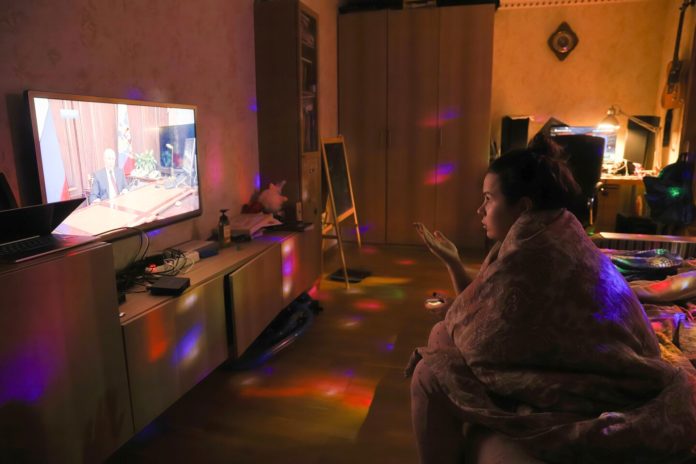
Two dozen media channels backed by the Russian government on Facebook experienced similar spikes in traffic, according to a Washington Post data analysis, then plummeted as the company instated a ban in Europe.
The muffling of the megaphone of the Russian state media, which has falsely framed the country’s invasion of Ukraine as “special operation” intended to protect Russian-speaking Ukrainians from Nazis, marks an unprecedented move by the social media giants to stop the spread of misinformation. And early signs show some of the actions may be working.
Traffic on YouTube and Facebook began to spike Feb. 22, two days before the invasion, according to The Post’s analysis of data provided by Facebook’s CrowdTangle tool and by New York University’s Center for Social Media and Politics. Russian channels including RT and Sputnik and dozens of offshoots in other languages pushed out false stories, claiming that Ukrainians had attacked Russians or describing a “genocide” against Russian-speaking Ukrainians in the separatist Donbas region.
Posts on Facebook from RT and Sputnik got more than 5 million likes, shares and comments Feb. 22 to Feb. 26, far more than usual. On YouTube, the videos were watched 73 million times.
Facebook‘s regional ban appears to have been less effective than YouTube’s global ban. Interactions with the two dozen Russian-controlled Facebook pages have returned to roughly prewar levels since March 1 — albeit with no traffic from Europe, where the pages are blocked.
The early data shows that actions taken by the U.S. tech giants have had some impact on Russia’s ability to push its narrative about the invasion out to the world, after years of concern from U.S. politicians and disinformation experts about the power of Russia’s propaganda machine. The situation underscores how powerful companies like YouTube, Facebook and TikTok have the ability to turn the dials of their content-recommendation algorithms to instantly shape the nature of information millions of people consume about a global war.
The removal of state media by Silicon Valley companies “illustrates the massive power of these platforms to challenge state power,” said Joan Donovan, research director of the Shorenstein Center on Media, Politics and Public Policy at Harvard Kennedy School. “Have they become too big to contain?”
Facebook declined to comment beyond its public statements, which have referred to its decisions to take action against state media in Europe as the result of the “exceptional nature of the current situation.” YouTube did not respond to a request for comment.
The data to support initial success by the companies is not definitive, and it’s still in the early days. Most news organizations experienced spikes and then drops in traffic as the war began, according to The Post’s analysis.
While there still was “some uncertainty” about the data, the trends are “likely an effect of social media companies doing a better job of social media companies labeling and/or restricting access to those domains,” said Kate Starbird, associate professor of human-centered design and engineering at the University of Washington and a leading expert on misinformation. “The structure of the systems does play a role in how information flows and many people lean heavily on the defaults — so if RT isn’t showing up in their feed anymore, then they aren’t going to be reading RT.”
Russian propaganda also spreads outside of official state media channels, and in recent days, a flood of disinformation put out by pro-Russian outlets falsely claiming that the United States operated coronavirus biolabs in the Ukraine has picked up momentum. And on Feb. 28, Facebook took down a small disinformation operation tied to Russia that ran a handful of websites masquerading as independent news outlets and published claims about the West betraying Ukraine and Ukraine being a failed state.
And even with the tech companies’ bans, the Kremlin has been racing to regain a foothold in the global information war. Some of that content is getting past tech company restrictions, particularly with channels that broadcast to audiences in developing countries.
RT Online, an Arabic-language Facebook page, experienced a 161.2 percent increase in interactions since Feb. 28, encompassing the period after the tech companies announced restrictions, according to a data analysis by the left-leaning human rights groups Avaaz. RT Play en Español saw a 22.5 percent increase. The official RT’s Arabic- and Spanish-language YouTube channels were more popular than its English one before they were blocked.
“Outside of what is happening on the ground, there is a global conversation taking place about how the world positions itself toward this war,” said Fadi Quran, campaigns director for Avaaz. “When Russian propaganda can continue to spread, it can skew the conversation in ways that are not conducive to finding a resolution to this conflict.”
RT was launched in 2005 as the TV channel Russia Today, part of an effort to improve Russia’s image abroad. Today, it has nine TV channels and a vast network of digital properties that operates in six languages and more than 100 countries, according to its website. (RT America, which is headquartered in Washington, announced it was shutting down operations this month.)
For years, Russian state media channels have grown steadily on U.S.-based social media networks, gaining massive followings and reaching audiences outside Russia’s borders. Organizations like RT covered a broad range of topics in a handful of world languages, and their digital-first approach helped them surpass more traditional outlets that were still focusing on radio and TV.
In South America and the Middle East, its TV channels and online properties get more traffic and viewers than major regional news outlets, as well as the Spanish- and Arabic-language versions of international news organizations such as the BBC.
RT’s main Facebook channel has more than 7 million followers, though it’s unclear how many are located in Europe where it’s blocked. Russian channels combined on Facebook have a total of at least 74 million followers, though some may be duplicates. RT’s main Arabic and Spanish properties are the most popular on Facebook, with more than 17 million followers each.
Before the block, RT’s YouTube account had roughly 4.65 million followers in English and 5.94 million in Spanish.
When RT became the first news network to surpass 1 billion views on YouTube in 2013, a senior YouTube executive joined an RT broadcast to mark the occasion, praising the Russian channel’s ability to deliver “authentic” content instead of “agendas or propaganda.”
Still, in 2018 and 2019, YouTube and Facebook respectively decided to label the channels as state-owned media. YouTube gave the same labels to the BBC and PBS, which are also supported by governments.
At Facebook, executives wanted to create one set of rules for all state-backed media, and it was difficult to craft rules that would separate “the good from the bad,” said a person familiar with the decision-making who spoke on the condition of anonymity to describe internal conversations. The company ended up launching two labels for state media, designating some that are partially state-owned and some that are wholly controlled by the state.
Well before the invasion, RT’s coverage of the war in Ukraine’s east pushed the idea that Ukrainian forces were oppressing ethnic Russians in the area, and that Russian-backed rebels were fighting for their freedom and human rights.
As news of Russia’s military buildup began dominating headlines, more people started watching RT — especially in Spanish and Arabic. YouTube’s algorithms often recommend content to viewers based on previous videos they watched, so someone who searched for news about the war might have been recommended an RT video. Facebook’s, too, rely on dozens of complex signals to choose which content to highlight in users’ feeds.
On Facebook, the Ukraine-related videos were some of the most recent popular videos from RT and Sputnik on politics. Like several other ideologically motivated news outlets, Russian state media posts a steady diet of human interest stories and videos of, for instance, a chipmunk eating almonds. But never before had the sites had so many popular videos all at once: A clip of Russian President Vladimir Putin calling for Ukrainian soldiers to put down their arms and go home received more than 25,000 likes, shares and comments in Spanish, Vietnamese and Arabic.
Once the invasion began, this messaging ramped up, with RT reports from the front lines refusing to use the word “war.” Instead, it used the Kremlin’s term, “special military operation.”
Around the time YouTube stopped recommending Russian state media videos to new viewers, traffic began dropping precipitously, according to The Post’s data analysis. Facebook and TikTok banned Russian state media in Europe at the end of February. On March 1, Google banned RT and Sputnik completely in Europe after the European Union added both organizations to its sanctions list, further limiting their traffic sources. Then on Friday, it went further and blocked them globally, causing views on RT and Sputnik to fall to zero.
Facebook has banned Russian state-backed channels only in Europe and says it is slowing down traffic elsewhere.
The changes made by the tech companies to dampen traffic to Russian propaganda came during a much broader effort to neuter Russia’s official argument about why it invaded Ukraine. Ukrainian politicians have been highly active on social media, posting videos and tweeting constantly, calling out Western companies who gave official Russian sources a platform and pushing their own viral content about Ukrainian heroism and its military, some of which turned out not to be true.
Together, the policy changes and mainstream support for Ukraine in Europe and the United States have made it difficult for Russian government channels to popularize their own message outside the country.
However, that could still change. Some of the dip could be related to a waning interest in invasion news. Experts say supporters of RT will seek their content elsewhere and go out of their way to boost it. That may account for the breakout success of some RT content over the last week.
For example, RT has also established accounts on two “alt-tech” video platforms, most closely associated with the right wing: Gab and Rumble. However, most RT videos have received around 1,500 views each on those sites, compared with 25,000 on YouTube before the ban.
Just last week, a Spanish-language video of Putin complaining that Russia’s worries over NATO expansion were “ignored” garnered nearly 300,000 views and more than 30,000 interactions on Facebook when it was posted by RT Play en Español, according to Avaaz. That was while it was blocked in Europe but visible elsewhere.
An Arabic-language video posted to Facebook on Tuesday quoted a person who claimed to be a Russian defense official arguing that American biological laboratories in Ukraine had tested samples of the coronavirus in bats. The video had 99,000 views.
Source link





